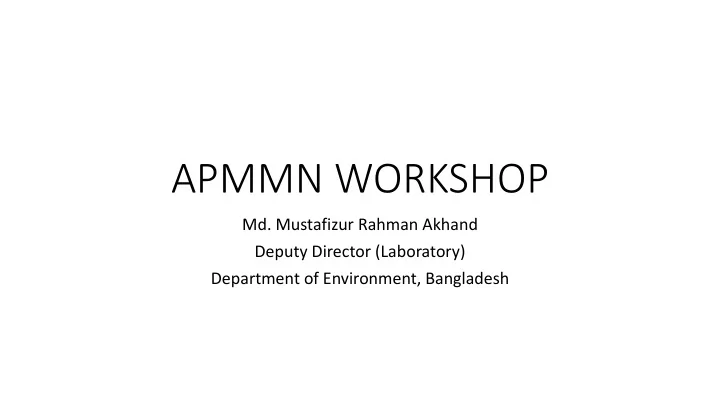

APMMN WORKSHOP Md. Mustafizur Rahman Akhand Deputy Director (Laboratory) Department of Environment, Bangladesh
• Ever since the Minamata incidence, the world became aware of the dangers of mercury released in the environment unchecked. Control of mercury emission needs critical attention in Bangladesh, where no major policies are at work to minimize the harms and enforcing positions low in the priority-list.
• The sources of all the pollution in Bangladesh are many. Such as – combustion of coal in power-stations, manufacture of products (cement, pesticides, chlorine, caustic soda, mirrors, medical equipment), industrial leaks, dentistry and waste incinerators.
• Of these, the primary consumers of mercury where demand is greatest are: Caustic-Chlorine Plant, Electronic Assembly industry, Dental Clinic, Ordinary Factory, Scientific & Commercial Stores, fairness products for humans.
• This demand is met by importing mercury from foreign countries since there is no opportunity of mining mercury in Bangladesh. For an idea of the volumes used generally - 3000Kg Mercury was imported in 2005-2006 of the imported qualities of which Caustic Chlorine Plant of a Pulp & Paper Mill used 2500 Kg and Remaining 500Kg was used by small industrial & commercial establishment. This amount has increased by the recent years.
• When we analyze the health care system we learn details and characterization of the problem. The estimated amount of mercury usages in health care equipments and products in Bangladesh is about 24.28 tons per year. Estimated annual Hg released by healthcare instruments is 6.9 tons, per capita Hg release 43.98 mg and per capita Hg usage in medical instruments 154.76 mg. The share of mercury released from thermometers and sphygmomanometers is 1.37 tons and 0.71 tons per year respectively. The contribution of Hg released from thermometers is 20%, sphygmomanometer 10%, laboratory usages 30% and other medical equipments 40%. Dentistry also uses mercury amalgams for filing purposes. Typically the hospitals manage their waste by disposing of them in City Corporation waste bins (dustbins). In the locations where these types of bins are unavailable, hospital authorities dispose of their waste into open spaces. In the educational sector (medical college) of Bangladesh, most of the educational institutions have no clear concept of mercury containing waste and therefore have no formal system of disposal.
• As for the Chlor-alkali industry in Bangladesh, Hg 0 is used as a flowing cathode in electrolytic cells. The chlor-alkali electrolysis process manufactures Cl 2 , H 2 , and NaOH caustic solution. Of these three, the primary product is Cl 2 . The majority of sodium hydroxide (caustic soda) is commercially produced through electrolytic cell processing in Chlor-Alkali factory. The balance is produced through chemical processes. The electrolytic cells used to make the caustic soda contain mercury. About 200 g Hg used per ton of Cl2 produced in this processes. The main consumers of produced chemicals from Chlor-Alkali factory in Bangladesh are Textile, Pulp & Paper, Food and Beverage Industry, Water Treatment Plants, Leather Industry and many other industries. Manufacturing processes that use mercury is Chlorine production, Portland cement, Caustic Soda, Power Generation (Coal combustion).
• Another major consumer is cement manufacturers. Currently Bangladesh registered a total of 74 cement plants, of which there are 30 in the production and installation capacity of 21 million tons, the annual consumption of 13 million tons, with production capacity 15 million tons. In 2013 total production capacity will reach 36 million tons, total 2013 consumption of 15.00 million tons. Bangladesh's total cement production capacity was 17 MT/year from 65 plants (The News Today, 2006). It is estimated that 45.6 mg of Hg emission occurs from a ton of cement production.
The Bangladeshi government has taken a few steps to minimize and monitor emission. They are: • Environment & Emission Standards on Mercury: • Environment Protection Rules 1997 has been set. • Emission Standard for Mercury into air 0.02mg/Nm3. • Emission STD for Mercury on to Surface Water 0.01mg/L. • Penalty for violation: Fine BDT 1 Million /5yrs imprisonment or both
The National Policies undertaken for Promoting Environmentally Sound Management of Mercury are: • National Environment Policy 1992 • Environment Conservation Act 1995 • Environment Protection Rules 1997 • Proceeds Rules 1998
Some actions were taken to identify polluters and control emission. Such as: • Shut down DDT Manufacturing Plant in 1996 • Mercury in Cell chlor-Alkali plants is replaced by Membranes cell • Existing Mercury cell plant recover is reaych mercury • No pesticide is suggested containing Mercury
However, the government faces many logistic and strategic limitations which require improvisation. The main requirement for the progress of monitoring and control of mercury emission are identified as: • Update and make strict laws and policies • Identify categorically, record and monitor mercury activities of potentially harmful industries. Penalize for deterrence of mercury abuse. • Raise awareness and enforcement within general public, manufacturers, politicians and the media • Find alternatives for industry-processes requiring mercury use, guide and supervise replacement of current manufacturing processes to cleaner ones. • Develop and train experts to function efficiently for actualizing the mandate for mercury reduction and replacement.
Right now, we are monitoring ambient air quality monitoring by Continuous monitoring station. There are altogether 11 station generating data on SPM, PM10, PM2.5, O3, Pd, Nox, Sox and CO. There is one monitoring station namely male decleration station where wet deposition to see the trans-boundary effect is recorded and heavy metals are detected for rain water.
• THANK YOU
Recommend
More recommend